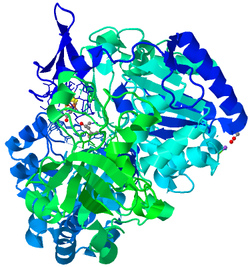
Summary
Acetylene hydratase (EC 4.2.1.112, AH) is a bacterial enzyme, originally discovered in the anaerobic microorganism Pelobactor acetylenicus,[1] that catalyzes the non-redox hydration of acetylene to form acetaldehyde.[2]


- C2H2 + H2O → CH3CHO
The mechanism is thought to involve attachment of acetylene to the metal followed by nucleophilic attack of water. Because acetylene binding to the Mo in nitrogenase lends some support that the mechanism involves a Mo→CH2=CH2 bond. Acetylene inhibits several microbial transformations where it interacts with the active site of the metal-dependent enzymes including hydrogenase and nitrogenase.[2] This enzyme relies on tungsten as the metal center and is the heaviest metal that plays a prominent part in the nitrogen, sulfur and carbon metabolic processes.[3] The [4Fe-4S] cubane keeps the W in the reduced W(IV) state, the most stable reduced oxidation state, while W(VI) is the other stable oxidation state (2nd and 3rd row transition metals are usually most stable in their highest oxidation state).[2] Mo and W enzymes ubiquitously involve W(IV)/W(VI) in the catalysis, however AH is very unique since the tungstoenzyme stays as W(IV) in the catalysis.[4] The tungstoenzyme stays as W(IV) throughout the catalysis because the enzyme catalyzes a non-redox reaction described as the hydration of acetylene to acetaldehyde.[5] The active site tungsten has a distorted octahedral geometry that is coordinated by molybdopterin co-factors along with a cysteine residue coordinated by a water molecule as the sixth ligand.[4] The active site residues are Asp13, Cys12, Trp179, Arg606, Met140 and Ile142.[3] Asp13 plays an important role in assisting the catalysis where the active site residue deprotonates the water hydroxide making it a better nucleophile.[3]
References edit
- ^ Schink B (1985). "Fermentation of acetylene by an obligate anaerobe, Pelobacter acetylenicus sp. nov". Archives of Microbiology. 142 (3): 295–301. doi:10.1007/BF00693407. S2CID 9331029.
- ^ a b c Kroneck PM (March 2016). "Acetylene hydratase: a non-redox enzyme with tungsten and iron-sulfur centers at the active site". Journal of Biological Inorganic Chemistry. 21 (1): 29–38. doi:10.1007/s00775-015-1330-y. PMID 26790879. S2CID 254088239.
- ^ a b c Liao RZ, Yu JG, Himo F (December 2010). "Mechanism of tungsten-dependent acetylene hydratase from quantum chemical calculations". Proceedings of the National Academy of Sciences of the United States of America. 107 (52): 22523–22527. doi:10.1073/pnas.1014060108. PMC 3012519. PMID 21149684.
- ^ a b Vidovič C, Belaj F, Mösch-Zanetti NC (September 2020). "Soft Scorpionate Hydridotris(2-mercapto-1-methylimidazolyl) borate) Tungsten-Oxido and -Sulfido Complexes as Acetylene Hydratase Models". Chemistry: A European Journal. 26 (54): 12431–12444. doi:10.1002/chem.202001127. PMC 7589279. PMID 32640122.
- ^ Seiffert GB, Ullmann GM, Messerschmidt A, Schink B, Kroneck PM, Einsle O (February 2007). "Structure of the non-redox-active tungsten/[4Fe:4S] enzyme acetylene hydratase". Proceedings of the National Academy of Sciences of the United States of America. 104 (9): 3073–3077. doi:10.1073/pnas.0610407104. PMC 1805521. PMID 17360611.


